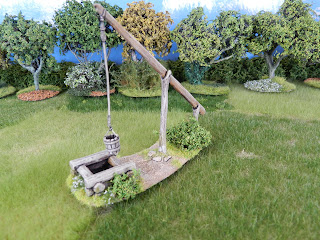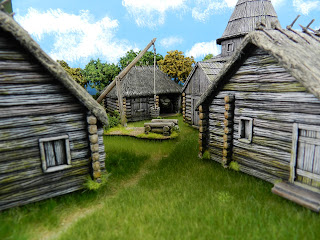Here we go with the last of the Russian stuff and then it will be on to pastures new.

Monday, 7 February 2022
Russian Village
Saturday, 5 February 2022
Russian Church
Here's the largest of the Russian buildings I made. Some were much more elaborate but this is typical for a Russian village from the Middle Ages to the twentieth century. It's built almost entirely from balsa wood. This one's a little larger than I usually like to make and the walls consumed an outrageous amount of balsa dowel: I think it was twelve metres, £30-odd's worth, and that was years ago. But it goes together easily enough with a bit of patience. I described the technique in the comments on the Russian houses.
A wargaming friend asked me very recently how I paint the aged woodwork, so this might be a good place to explain. Firstly you need to get a very thorough undercoat of matt black over every millimetre of the surface, making sure you get into the cracks and crevices and checking from every angle. Then it's mostly careful drybrushing with a big flat bristle brush. I learned the concept of this colour sequence from an article by Dave Andrews in White Dwarf long ago:
- Dark brown, applied quite heavily, leaving black mostly just in the cracks.
- Medium grey-brown, somewhat more lightly applied
- Light grey with a touch of buff, sand or whatever mixed in. This is a light drybrush only.
- Wash over some individual logs or planks to vary the colour. Well-thinned inks, or washes by GW or whoever: black, dull and bright browns are what you want.
- Final very light drybrush with a pale silver-grey colour.
- I often also add a hint of moss with very thin olive-green, spotted on randomly and immediately softened by dabbing with a damp ball of tissue.
Thursday, 3 February 2022
Russian Village Fences
Today's instalment of rustic Russian stuff consists of some fencing I made in styles characteristic of the area from ancient times to the twentieth century. I researched them mostly from a photographic survey of rural Russia in about 1910, which is easily found online. Surprisingly, these quite early photographs are in colour. I picked out three of the more interesting and atmospheric styles they revealed for my models.
Tuesday, 1 February 2022
Laser-Cut MDF Kits
When making the Russian village stuff I worked on two laser-cut MDF kits, which Garry Broom had been given by our late friend Mark. They are by 4Ground and only just about compatible size-wise with what I'd already made. I'm not a massive fan of MDF kits, to put it mildly, but thinking they'd be good for the skirmish end of what we wanted from these Russian buildings, I was determined to do what I could with them. I think laser cut stuff works best when aiming to represent wooden buildings and least well in any attempt to model tiles, slates, etc. In this case, they are wooden buildings with a bit of crumbling render, so not too bad.
I worked on them by first of all trying to add to the wood grain on the roof, scoring a bit more texture with super-rough sandpaper, although I'm not sure this added very noticeably. I plugged the hideous locating holes and lugs in the roof with green stuff. I remodelled the rendered areas using household filler in my usual way. I left off the useless porches and lean-to's which just increase the already huge footprint without adding anything useful. And although these are sold as "pre-painted", I completely repainted the kits to pull them closer in style and colour to my own models. I think they've come out useable in the end, at least for skirmish gaming and they have featured in one or two Chain of Command WWII games.
At the risk of labouring the point, these are awfully big. Perhaps a 28mm Russian peasant would be delighted to enjoy such spacious accommodation, but I have a bit of thing against over-large wargames buildings. You can see the comparative size in the last photo. The first building is about my usual size. The mashed up plastic kit one in the middle has a footprint over 50% bigger and the MDF one is 130% bigger. I could get a village in that space!
-
I will soon have a second batch of French 1870 staff conversions to show you, but for now here is an article I wrote for the Foreign Corresp...




















